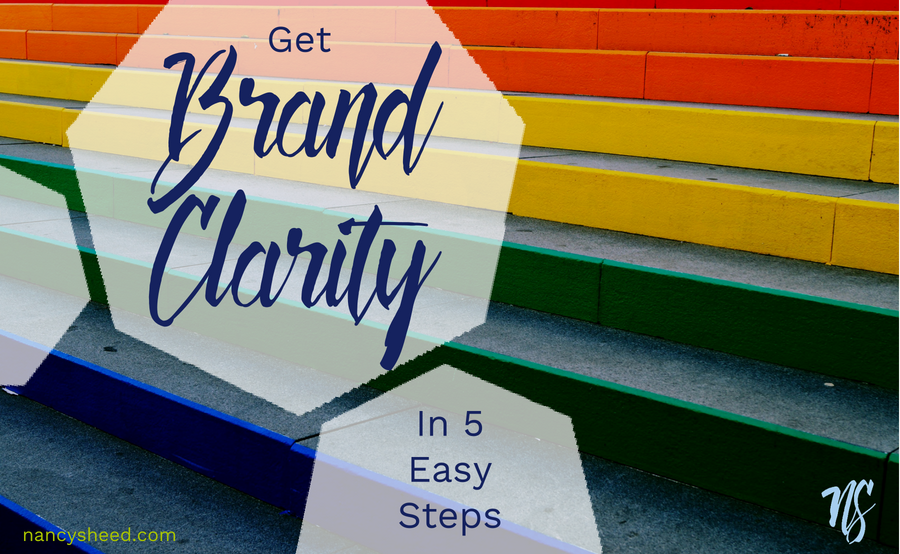As we’re halfway through 2018, now is a perfect time to take inventory of your brand and gain the clarity you need to make any needed shifts to ensure you end this year on top with focused and successful marketing.
I’ve recently been working on some projects with Vicky Vitarelli of V dot V Marketing, and we wanted to share what we think is a basic and practical approach to branding and marketing. We did a Facebook LIVE video to break down the 5 steps or elements to clearly defining your brand.
What is a brand?
VV: It’s how you tell the story about your product and/or services to your customers. It’s how you differentiate yourself from your competitors or entice people to engage with your brand and become clients.
NS: I’ll add that it’s important to figure this out because when you have your brand elements clearly defined, it’s much easier to put your marketing plan in place. You aren’t guessing, and you can be much more consistent in all areas of your marketing.
VV: As we jump into these 5 elements I want people to think about this as a lens that they use to see their brand. You know when you go to the eye doctor and they have you look through the lens and say better/worse? Use that approach to hone it on what parts of these elements are already great and what needs changing or updating.
Brand element No. 1: The physical attributes.
What does it look like? It will include your logo, your colors and fonts used on your materials. All of the things that you use to visually represent your brand identity.
NS: Many people stop right here, but this is just one element of your brand.
Brand element No. 2: Your communication style.
What to do you sound like? Are you a leader, a guide or authority? What type of vocabulary do you use in your messaging? What is the tone? How do you want others to hear you? Soft and nurturing or empowering and bold?
NS: How do your customers experience the way you communicate? How do they hear you?
VV: Right! It’s important to remember that every touch point that your customer has with you is significant. Brand voice shows up everywhere. In your invoices, your web copy, your blog posts. Each part of what a client experiences should have the same voice.
NS: Yes! It’s important not to let some areas become boiler-plate. If you outsource copy and writing it’s important that they understand as well. It’s not just about the facts and figures, they also need to understand the voice and how you want to sound so you stay consistent.
Brand element No. 3: What is your brand promise?
You may be selling a service, or a physical product or a book or a combination of those things. Let’s say people are selling consulting services. That’s not really what your clients are buying. They are buying the solution. An author is selling a book, but they are also selling the messaging in the book. The solution is what your client is buying.
This is also a great place to get clear on why people are buying from you or not buying? Often, digging in to find out why your message is different is a good way to really get clear your unique brand promise.
VV: A great example is the Mastercard “Priceless” campaign. At the time this was conceived, Mastercard was number 2 in their industry. We decided to use that and say Mastercard is for those special purchases, the ones that have to happen, the ones that are not every day. And it worked!
NS: Your brand promise are the benefits around what you are selling and what your clients are looking for.
Brand element No. 4: Who are you selling to?
I often hear people say “Everyone can use my product or service.” And that might be true, but everyone isn’t looking for it and everyone isn’t necessarily going to purchase. If you want to market to everyone it requires a massive budget to reach everybody.
Instead, let’s focus in on who will get the most benefit of what you are selling and really clarify that. Demographics are one part. Men or women? What age? Sometimes a geographic component might be important.
Even more important, what is the mindset? What are they thinking? If everyone can use what you’re selling why don’t they have it already?
NS: When you’re clear on this it then makes brand voice so much easier to define as well. When you know exactly who you’re “talking to” you can use tone and vocabulary that fits them specifically and will resonate with them. Writing for “everybody” means generic communications that aren’t going to resonate with anyone.
Who are your people, your tribe? When you get really clear here and it makes everything much easier.
Brand element No. 5: How do you know what your clients really want?
Do client research. Talk to them and ask them to share their experience with your company. Not just the product, but all aspects. The buying experience, customer service, ease of use etc. How did the product or service impact their life? Why did they choose you? How did they find you? What else did they consider before buying from you? Did you meet their expectations?
If you are new and don’t have clients, interview your prospects and find out from them why and how they go about making the decision to buy from you.
You will be able to understand their pain points and then you can shape your messaging to speak to that in a well-defined way.
NS: Remember that anyone can do this too. You don’t have to have access to a research firm. You can track these things from reviews, comments online, responses to your emails, as well making it a practice to ask customers for their feedback. Make it easy for them to let you know and they will be happy to share that with you.
VV: Creating ways to listen to your readers, clients and customers on a regular basis will help you create marketing strategies that stay relevant and resonate.
Summary: The Five Steps To Do Your Own Brand Audit
- What do you look like?
- What do you sound like?
- What is your brand promise?
- Who are you selling to?
- Listen, ask and stay mindful of comments of customers to continue to guide you.
Branding means different things depending on our background and where you are in your business. This approach is meant to keep it simple and focused, so you can identify what you want to say, who you want to say it to, and how to best communicate the way you serve your clients or customers.
Are you clear with all of the elements of your brand? Where are you stuck? Where do you need help? Leave a comment below or connect on Facebook and share!
Want to schedule time with Nancy? Click here for a free consultation call!


